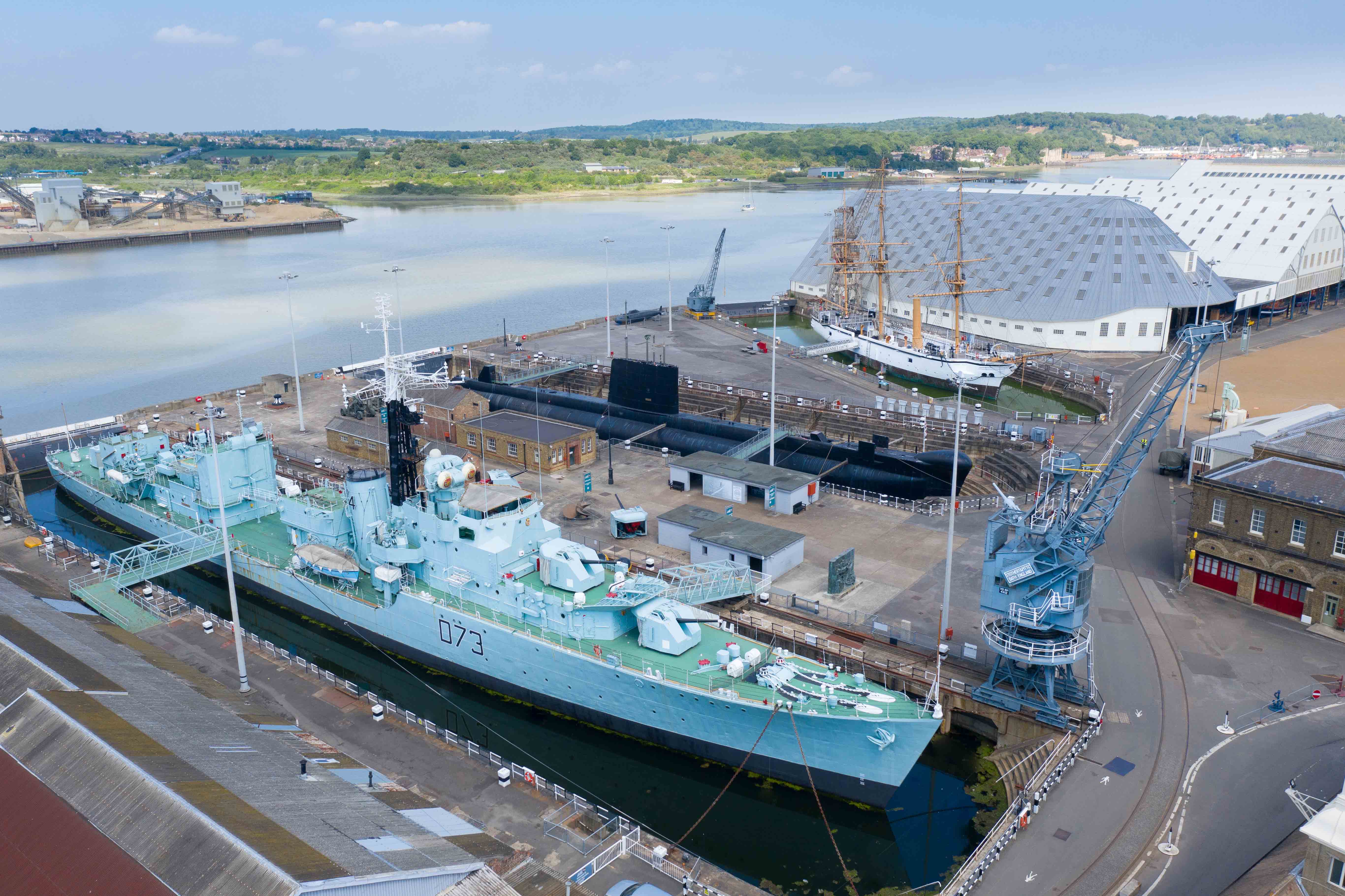Chatham Dockyard: Kent's Naval Heritage
Explore the 400-year history of one of Britain's most important royal dockyards, from the Age of Sail to the 20th century.
Read More

For over a century, HMS Pembroke stood as one of the Royal Navy's most significant shore establishments, training generations of naval personnel and playing a crucial role in both World Wars. This historic naval barracks, located adjacent to Chatham Dockyard in Kent, represents an important chapter in Britain's maritime heritage and the county's military history.
HMS Pembroke was originally established in 1878, taking its name from the third-rate HMS Pembroke, a 74-gun ship of the line built in 1812 that had become a base ship at Chatham in 1873. Initially, HMS Pembroke operated as a hulk (a decommissioned vessel used as accommodation), serving as floating accommodation for naval personnel.
In the late Victorian era, as the Royal Navy modernised and expanded, a decision was made to create permanent shore accommodations for naval personnel. Construction of the impressive shore barracks began in 1897, with the building designed by Sir Henry Pilkington, Director of Works for the Admiralty. The new Royal Naval Barracks were officially opened in 1903, with HMS Pembroke moving ashore from its floating accommodation.
The shore barracks at Chatham were designed in an impressive neo-classical style, featuring a grand façade with columned entrances, ornate stonework, and symmetrical wings. The main building complex centred around a large parade ground, with accommodation blocks arranged in a quadrangle pattern. Additional buildings included mess halls, administrative offices, training facilities, and a large drill hall.
The architectural design of HMS Pembroke reflected the Royal Navy's status and prestige during Britain's imperial height. The barracks were constructed using red brick with Portland stone dressings, creating a striking appearance that commanded respect and represented naval authority. The complex exemplified the grand institutional architecture of the late Victorian and Edwardian periods.
During the First World War, HMS Pembroke served as a crucial training and administrative centre for the Royal Navy. The barracks accommodated thousands of naval personnel, with many being trained before deployment to the fleet. The Chatham Division, headquartered at HMS Pembroke, provided crews for numerous warships throughout the conflict.
One of the most tragic incidents in HMS Pembroke's history occurred on 3rd September 1917, when the barracks were targeted in a German air raid. The Drill Hall, which was being used as temporary accommodation due to overcrowding, received a direct hit from a bomb dropped by a Gotha bomber. The attack resulted in 136 deaths and many more injuries, marking one of the worst losses of life from air raids in Britain during the First World War.
"The terrible raid on HMS Pembroke remains one of the darkest moments in Chatham's history. The sight of over a hundred coffins lined up for the military funeral procession left an indelible mark on the local community." - Historical account from local newspaper archives, September 1917
Between the world wars, HMS Pembroke continued to function as an important shore establishment. It housed various training schools, including signals, gunnery, and later, supply specialisations. The interwar period saw fluctuations in personnel numbers as the Royal Navy adjusted to peacetime constraints and subsequent rearmament.
During the Second World War, HMS Pembroke once again became a vital facility for the Royal Navy's war effort. The barracks supported naval operations in the Channel and North Sea, while continuing to train personnel for service throughout the fleet. Chatham itself was a target for bombing raids, and HMS Pembroke suffered damage, though not as catastrophic as during the First World War.
The barracks played an important role in supporting Operation Dynamo (the Dunkirk evacuation) in 1940, with many small vessels setting out from the Medway area. Throughout the war, HMS Pembroke maintained its crucial function as a training centre and administrative hub for naval personnel.
Following the Second World War, HMS Pembroke's role evolved as the Royal Navy underwent significant changes. The post-war period saw a gradual reduction in the size of Britain's naval forces, with corresponding adjustments to shore establishments. However, HMS Pembroke remained an important facility, particularly for specialist training.
In 1959, HMS Pembroke became the home of the Royal Navy Supply School, focusing on logistics, supply chain management, and administrative training. This specialisation reflected the increasing technical and professional nature of naval service in the modern era. For several decades, the establishment trained generations of supply officers and ratings who would serve throughout the fleet.
The barracks continued to serve as a base for naval personnel, though in gradually decreasing numbers as the century progressed. Despite the reductions, HMS Pembroke maintained its proud traditions and continued to be an important part of the Royal Navy's shore infrastructure until the early 1980s.
The 1981 Defence White Paper led to significant restructuring of Britain's armed forces, including the Royal Navy. As part of these changes, HMS Pembroke was earmarked for closure. The establishment was finally decommissioned in 1983, ending over a century of naval presence at the site.
Following its closure as a naval facility, the buildings remained largely unused for several years. However, the architectural and historical significance of the complex ensured its preservation. In the early 21st century, the buildings underwent extensive renovation and repurposing to create the Universities at Medway campus, a joint venture between the University of Kent, the University of Greenwich, and Canterbury Christ Church University.
Today, the former HMS Pembroke buildings serve as educational facilities, with thousands of students occupying spaces once filled by naval personnel. The impressive façade and structure have been preserved, maintaining an important link to Kent's naval heritage. The site's naval history is commemorated through displays, information boards, and the preservation of architectural features that tell the story of HMS Pembroke's contribution to British maritime history.
The legacy of HMS Pembroke lives on not just in the preserved buildings but also in the memories and records of the thousands who served there. The establishment played a significant role in the lives of countless naval personnel, from new recruits receiving their initial training to experienced sailors and officers enhancing their skills.
The HMS Pembroke war memorial, commemorating those lost in the 1917 air raid, stands as a poignant reminder of the sacrifices made by naval personnel. Annual ceremonies continue to be held, particularly on the anniversary of the raid, ensuring that the service and sacrifice of those who passed through the barracks are not forgotten.
For local residents of Chatham and the wider Medway towns, HMS Pembroke represents an important chapter in the area's maritime identity. Though the Royal Navy has long since departed from Chatham, the impressive buildings of the former naval barracks stand as a testament to the town's naval heritage and its contribution to Britain's maritime power.
While the former HMS Pembroke is now an educational campus, visitors interested in the naval history of the site can still appreciate the impressive architecture and learn about its past. The Universities at Medway campus is generally open to the public, allowing visitors to view the exterior of the buildings and some of the public spaces.
For those seeking a more comprehensive understanding of Chatham's naval heritage, the nearby Historic Dockyard Chatham offers extensive exhibitions on the Royal Navy's presence in the area. The dockyard includes displays related to HMS Pembroke and the wider history of naval operations from Chatham.
The story of HMS Pembroke forms an integral part of Kent's military and maritime history. From its origins in the Victorian era through two World Wars to its final years as a specialist training establishment, HMS Pembroke exemplifies the evolution of the Royal Navy in the modern age and remains an important element of Britain's naval heritage.